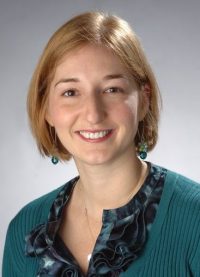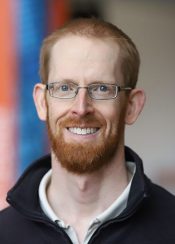Syracuse University takes great pride in its R1 designation as a world-class leader in research according to the Carnegie Classification of Institutions of Higher Education.
One of the visible examples of how the University is leading the way in research excellence is the BioInspired Institute, an interdisciplinary institute whose members examine complex biological systems, developing and designing programmable smart materials to address global challenges in health, medicine and materials innovation.
BioInspired serves as a framework for Syracuse University’s talented faculty and student researchers, supporting researchers from such disciplines as life sciences, engineering, physics and chemistry. It collaborates with both industry partners and other academic institutions, including SUNY Upstate Medical University, SUNY College of Environmental Science and Forestry and others.
Helping the current and next generation of Syracuse researchers achieve their goals fuels Lisa Manning, who served as BioInspired’s founding director beginning in April 2019, and James H. (Jay) Henderson, who took over as director on July 1. The two have frequently collaborated to provide a roadmap for successful research endeavors on campus.

Lisa Manning
“BioInspired is at the intersection of materials and living systems. The idea is there’s types of materials called biomaterials that interact with living systems, and there are types of materials that are bioinspired, which means they have features or functions or can execute tasks like intelligent new types of materials that act like living systems,” says Manning, the William R. Kenan Jr. Professor of Physics in the College of Arts and Sciences. “There’s this idea that organisms are actually secretly a material. By thinking about living systems as materials or having mechanical interactions, we can come up with new hypotheses that might even someday drive treatments for a disease.”

Jay Henderson
“We’re trying to figure out ways to solve really big problems like antimicrobial resistance to antibiotics or how we can better treat injuries when they occur,” says Henderson, professor of biomedical and chemical engineering in the College of Engineering and Computer Science. “How can we use materials to try to do those things? Some of the biggest challenges facing our society might have solutions rooted in the materials we could use to address them, whether it’s treating an injury or a disease, or capturing energy in some way that it can’t currently be captured to address things like global warming or combating COVID. These are problems we’re going to continue to face in the future.”
On this “’Cuse Conversation,” Henderson and Manning share how BioInspired embraces an interdisciplinary approach to research, discuss the importance of introducing students to research opportunities early in their academic careers and explain how BioInspired and Syracuse University are helping more women and students from underrepresented populations get involved in science, technology, engineering and math (STEM) fields.
They also explore the Cluster Hires Initiative—a key part of the academic strategic plan intended to significantly invest in faculty recruitment and retention in areas of distinction for the University—preview the second annual BioInspired Symposium, scheduled for Oct. 19-20, and explain how they became passionate about research.
Check out episode 151 of the “’Cuse Conversations” podcast featuring Henderson and Manning. A transcript [PDF] is also available.

Jay Henderson and Lisa Manning discuss BioInspired’s interdisciplinary approach to research, the importance of introducing students to research opportunities early in their academic careers and what BioInspired and Syracuse University are doing to get more women and students from underrepresented populations into STEM fields.
What led to the establishment of BioInspired and how has the institute embraced an interdisciplinary approach to research?
Manning: There were niche areas of research excellence already in place at Syracuse, and we had this idea that we could do cluster hiring for new faculty who would really drive forward the R1 status of our institution and build the space for undergraduates to do this type of research. There’s a competition for proposals for new faculty hires. Jay and I have a long history of collaborating. He brought me onto the very first grant proposal I ever got at Syracuse, and we collaborated to help conceive how different groups in different departments and colleges could work together and hire in between those areas of excellence.
We wanted to build something cohesive that’s new and outside of any one department. It was the type of research you couldn’t do unless you had these different pieces together.
Why is it so important to introduce students to research opportunities early in their academic careers?
Henderson: Research is a fantastic way to help students figure out what they want to do and how they want to impact the world, and that’s why I’m so passionate about ensuring they’re aware of the opportunities that are available to them early on. Syracuse University has a lot of resources to make that possible. We’re lucky as an institute to be able to team with units on campus like the Syracuse Office of Undergraduate Research and Creative Engagement [The SOURCE], whose mission is to provide ways to support undergraduate researchers as they get started on their own research careers.
That’s the exciting part about undergraduate research—getting them outside the classroom and giving them opportunities to learn about what they might want to do or maybe what they don’t want to do.
When it comes to STEM fields, what programming is in place to broaden the pipeline and get more women and underrepresented people into STEM?
Henderson: We have a pre-college Career Acceleration via Rigorous Educational Experiences in Research (CAREER) program that’s meant to get students oriented to what research is and how they could get involved as early as their first semester on campus to help them hit the ground running. We try to make sure they understand what doors research could open, what experiences it could give them and how they can go about getting their foot in that door. We help them understand how to reach out to their professors and ask about research opportunities.
Throughout their four years, we have additional programming to help students continue to up their game so they’ll have more and more research opportunities to get these formative experiences, strengthen their toolkit and build their resume.
Manning: The idea behind the CAREER program within BioInspired is that we’re trying to provide a welcoming environment to a diverse population of students. That program is in partnership with some of our historically Black colleges and universities, including Hampton University and North Carolina A&T University.
Jay and I have run boot camps with faculty members and bring in students from those two universities. We’ve expanded that program to provide longitudinal support over the whole lifespan of college. Folks from underrepresented populations might not see an environment that’s welcoming to them, which can lead to their drifting out of the pipeline over time at every stage.
Our goal is to provide support at every stage so there are more on-ramps to being in STEM. Right now, we’re supporting this difficult but important work directly from BioInspired because it’s a key value for our institute and we hope to get more money from the federal government to continue it and broaden the program.
The campus community is invited to celebrate the amazing work of BioInspired during the second annual BioInspired Institute Symposium, Oct. 19-20. What are the goals and objectives of the symposium?
Henderson: This is a fantastic opportunity to learn about the cutting-edge research being done now. Those who come will see the ways in which BioInspired is having an impact outside of the lab through outreach activities and other activities that our members participate in. In addition to being diligently active in the lab, many of our faculty get out into the community across the country and the world by leading projects and programs that help bring science to the public, introducing the public to opportunities to get involved in research.
I hope that people will come away with a better understanding of how science and the work being done out of the labs of the BioInspired Institute is having a positive day-to-day impact.
Manning: It’s amazing seeing everything come together that we collaboratively as a team knew were possible five years ago when we started conceiving this idea. If you would’ve told me back then we would be here now, I would not have believed you. This required some serendipity and a ton of buy-in from our faculty, staff and students. We believed what we were doing was worth the time. It’s really exciting to see all the impact that belief and hard work can have.
Note: This conversation was edited for brevity and clarity.
By: John Boccacino
